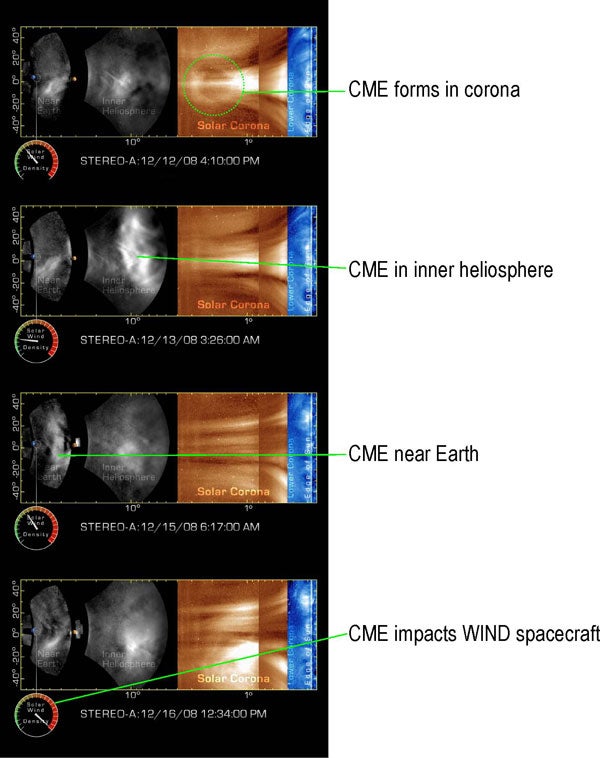The images from a December 2008 CME event reveal an array of dynamic interactions as the solar wind, traveling at speeds up to 1 million mph (1.6 million km/h), shifts and changes on its 3-day journey to Earth, guided by the magnetic field lines that spiral out from the Sun’s surface. Observed structures include the solar wind piling up at the leading edge of a CME, voids in the interior, long thread-like structures, and rear cusps. Quiet periods show a magnetic disconnection phenomenon called a plasmoid, “puffs” that correlate with in-situ density fluctuations, and V-shaped structures centered on the current sheet — a heliospheric structure in which the polarity of the Sun’s magnetic field changes from north to south.
“For the first time, we can see directly the larger-scale structures that cause blips in the solar wind impacting our spacecraft and Earth,” said Craig DeForest from SwRI. “There is still a great deal to be learned from this data, but it is already changing the way we think about the solar wind.”
“For 30 years, we have been trying to understand basic anatomy of CMEs and magnetic clouds, and how they correspond to their source structures in the solar corona,” said Tim Howard from SwRI. “By tracking these features through the image data, we can establish what parts of a space weather storm came from which parts of the solar corona, and why.”
The team used a combination of image processing techniques to generate the images over a distance of more than 1 astronomical unit (AU, or the Earth-Sun distance), overcoming the greatest challenge in heliospheric imaging, that of extracting faint signals amid far brighter foreground and background signals. Small “blobs” of solar wind tracked by the team were more than 10 billion times fainter than the surface of the Full Moon and 10 thousand times fainter than the star field behind them.
“These data are like the first demonstration weather satellite images that revolutionized meteorology on Earth,” said DeForest. “At a glance, it is possible to see things from a satellite that cannot be extracted from the very best weather stations on the ground. But both types of data are required to understand how storms develop.”
In particular, the new images reveal the shape and density of Jupiter-sized clouds of material in the so-called empty space between planets. In contrast, in-situ probes such as the WIND and ACE spacecraft reveal immense detail about the solar wind at a single point in space.
The images from a December 2008 CME event reveal an array of dynamic interactions as the solar wind, traveling at speeds up to 1 million mph (1.6 million km/h), shifts and changes on its 3-day journey to Earth, guided by the magnetic field lines that spiral out from the Sun’s surface. Observed structures include the solar wind piling up at the leading edge of a CME, voids in the interior, long thread-like structures, and rear cusps. Quiet periods show a magnetic disconnection phenomenon called a plasmoid, “puffs” that correlate with in-situ density fluctuations, and V-shaped structures centered on the current sheet — a heliospheric structure in which the polarity of the Sun’s magnetic field changes from north to south.
“For the first time, we can see directly the larger-scale structures that cause blips in the solar wind impacting our spacecraft and Earth,” said Craig DeForest from SwRI. “There is still a great deal to be learned from this data, but it is already changing the way we think about the solar wind.”
“For 30 years, we have been trying to understand basic anatomy of CMEs and magnetic clouds, and how they correspond to their source structures in the solar corona,” said Tim Howard from SwRI. “By tracking these features through the image data, we can establish what parts of a space weather storm came from which parts of the solar corona, and why.”
The team used a combination of image processing techniques to generate the images over a distance of more than 1 astronomical unit (AU, or the Earth-Sun distance), overcoming the greatest challenge in heliospheric imaging, that of extracting faint signals amid far brighter foreground and background signals. Small “blobs” of solar wind tracked by the team were more than 10 billion times fainter than the surface of the Full Moon and 10 thousand times fainter than the star field behind them.
“These data are like the first demonstration weather satellite images that revolutionized meteorology on Earth,” said DeForest. “At a glance, it is possible to see things from a satellite that cannot be extracted from the very best weather stations on the ground. But both types of data are required to understand how storms develop.”
In particular, the new images reveal the shape and density of Jupiter-sized clouds of material in the so-called empty space between planets. In contrast, in-situ probes such as the WIND and ACE spacecraft reveal immense detail about the solar wind at a single point in space.










